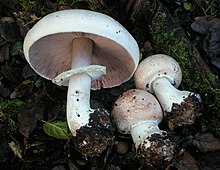Agaricus hondensis
| Agaricus hondensis | |
|---|---|

| |
| Scientific classification | |
| Domain: | Eukaryota |
| Kingdom: | Fungi |
| Division: | Basidiomycota |
| Class: | Agaricomycetes |
| Order: | Agaricales |
| Family: | Agaricaceae |
| Genus: | Agaricus |
| Species: | A. hondensis
|
| Binomial name | |
| Agaricus hondensis Murrill (1912) | |
| Synonyms[2] | |
|
Agaricus bivelatoides Murrill (1912) | |
| Agaricus hondensis | |
|---|---|
| Gills on hymenium | |
| Cap is convex or flat | |
| Hymenium is free | |
| Stipe has a ring | |
| Spore print is brown to purple-brown | |
| Ecology is saprotrophic | |
| Edibility is poisonous | |
Agaricus hondensis, commonly known as the felt-ringed agaricus, is a species of
The fungus produces
Systematics
The species was first
Agaricus hondensis has traditionally been
Description

The cap is initially convex before flattening out, and reaches a diameter of 6–15 cm (2+1⁄2–6 in). The dry and smooth cap surface is whitish or has pale pinkish-brown to pinkish-gray to fawn-colored flattened fibrils or fine fibrillose scales (at least in the center). In maturity, the fibrils usually darken to brown, reddish-brown, or reddish-gray, but in one northern form the fibrils are darker brown from the beginning. The flesh is thick and white. When bruised or injured, the flesh either does not change color, or may stain pale yellowish, then often slowly discolors pinkish. The odor of the crushed flesh is mild or faintly phenolic, but is usually distinctly phenolic in the base of the stipe.[7]
The gills are initially pale pinkish to pinkish-gray before becoming brown, then chocolate-brown or darker when the spores mature. In maturity, the gills are free from attachment to the stipe, and are packed close together with little intervening spaced between them. The stipe is 7–20 cm (2+3⁄4–7+7⁄8 in) long, and 1–3 cm (1⁄2–1+1⁄4 in) thick but with a thicker or bulbous base.[8] Firm, smooth, and lacking the scales found on the cap, the stipe is white but discolors dingy pinkish or brownish in age or after handling. The flesh in the extreme base usually stains pale yellowish when bruised. The partial veil is membranous, white, and forms a thick, felt-like ring on the upper portion of the stipe. The ring is skirtlike but often flares outward instead of collapsing against the stipe.[7] A drop of dilute potassium hydroxide placed on the cap turns yellow.[9]

Similar species
Distinctive field characteristics of Agaricus hondensis include its woodland habitat, the yellow staining reaction with KOH, and its odor.
Habitat and distribution
A
Toxicity
Agaricus hondensis mushrooms are
See also
- List of Agaricus species
References
- ^ from the original on 2015-09-23. Retrieved 2012-07-13.
- ^ a b "Agaricus hondensis Murrill 1912". MycoBank. International Mycological Association. Archived from the original on 2015-12-22. Retrieved 2012-07-13.
- ^ from the original on 2015-09-23. Retrieved 2012-07-13.
- JSTOR 2481312.
- ^ ISBN 978-0-88902-977-4. Archivedfrom the original on 2014-06-12. Retrieved 2016-10-14.
- ^ PMID 16722221.
- ^ ISBN 978-0-89815-169-5.
- ^ OCLC 797915861.
- ^ a b c Kuo M. (February 2005). "Agaricus hondensis". MushroomExpert.com. Archived from the original on 2014-10-08. Retrieved 2014-01-04.
- ^ ISBN 978-0-394-51992-0.
- ^ Blanco-Dios JB. (2001). "Agaricales des dunes de Galice (nord-ouest de l'Espagne). 1. Agaricus freirei Blanco-Dios, sp. nov". Documents Mycologiques (in French). 31 (127): 27–34.
- ISBN 978-90-5410-495-7.
- ISBN 978-0-395-91090-0.
- ^ ISBN 978-0-88192-935-5. Archivedfrom the original on 2014-06-12. Retrieved 2016-10-14.
- ISBN 978-0-919433-47-2.
- ISBN 978-0-470-33557-4. Archivedfrom the original on 2014-06-12. Retrieved 2016-10-14.
- ^ Terry CJ (1978). "Food habits of three sympatric species of insectovora in western Washington". Canadian Field-Naturalist. 92: 38–44. Archived from the original on 2015-02-21. Retrieved 2019-06-05.
- PMID 17252436.
External links
